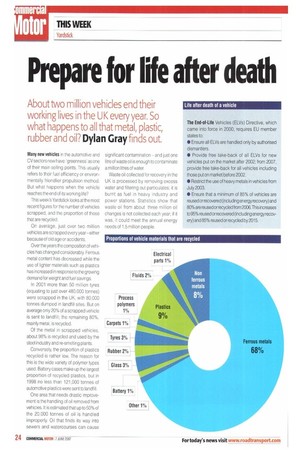Prepare for life after death
Page 24

If you've noticed an error in this article please click here to report it so we can fix it.
About two million vehicles end their working lives in the UK every year. So what happens to all that metal, plastic, rubber and oil? Dylan Gray finds out.
Many new vehicles in the automotive and CV sectors now have 'greenness' as one of their main selling points. This usually refers to their fuel efficiency or environmentally friendlier propulsion method. But what happens when the vehicle reaches the end of its working life?
This week's Yardstick looks at the most recent figures for the number of vehicles scrapped, and the proportion of those that are recycled.
On average, just over two million vehicles are scrapped every yeareither because of old age or accidents.
Over the years the composition of vehicles has changed considerably. Ferrous metal content has decreased while the use of lighter materials such as plastics has increased in response to the growing demand for weight and fuel savings.
In 2001 more than 50 million tyres (equating to just over 480,000 tonnes) were scrapped in the UK, with 80,000 tonnes dumped in landfill sites. But on average only 20% of a scrapped vehicle is sent to landfill; the remaining 80%, mainly metal, is recycled.
Of the metal in scrapped vehicles, about 98% is recycled and used by the steel industry and re-smelting plants.
Conversely, the proportion of plastics recycled is rather low. The reason for this is the wide variety of polymer types used. Battery cases make up the largest proportion of recycled plastics, but in 1998 no less than 121,000 tonnes of automotive plastics were sent to landfill.
One area that needs drastic improvement is the handling of oil removed from vehicles. It is estimated that up to 50% of the 20,000 tonnes of oil is handled improperly. Oil that finds its way into sewers and watercourses can cause significant contamination and just one litre of waste oil is enough to contaminate a million litres of water.
Waste oil collected for recovery in the UK is processed by removing excess water and filtering out particulates; it is burnt as fuel in heavy industry and power stations. Statistics show that waste oil from about three million oil changes is not collected each year; if it was, it could meet the annual energy needs of 1.5 million people.






















































































































































































